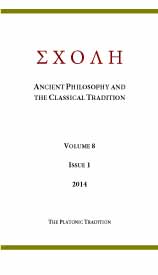THE BEAUTY OF THE WORLD IN PLATO’S TIMAEUS
THE BEAUTY OF THE WORLD IN PLATO’S TIMAEUS
Author(s): Dominic O'MearaSubject(s): Philosophy
Published by: Новосибирский государственный университет
Keywords: Aesthetics; Antiquity; harmony; the beautiful and the good; kalos kagathos
Summary/Abstract: In the Timaeus Plato describes the world as the ‘most beautiful’ (kallistos, 29a5) of generated things. Perhaps indeed this is the first systematic description of the beauty of the world. It is, at any rate, one of the most influential statements of the theme. The Stoics were deeply convinced by it and later, in the third century A.D., at a time when contempt and hate for the world were propagated by Gnostic movements, Plotinus, interpreting the Timaeus, would write magnificent passages on the beauty and value of the world. But what does Plato mean by the ‘beauty’ of the world? What makes the world beautiful? In this paper these questions are approached first (1) by a brief discussion of the distinction which Plato appears to make in the Timaeus between beauty and the good. In one passage (Tim. 87c) ‘measure’ seems to relate to this distinction. It is suitable then (2) to look at a section of another late work of Plato, the Philebus, where the themes of beauty, goodness and measure may be compared in more detail. The theme of measure then takes us back (3) to the Timaeus, in order to examine the role played by measure, in particular mathematical measure, in constituting the beauty of the world. I discuss in detail the way in which mathematical structures make for the beauty of soul and body in the living whole that is the world.
Journal: ΣΧΟΛΗ. Философское антиковедение и классическая традиция
- Issue Year: VIII/2014
- Issue No: 1
- Page Range: 24-33
- Page Count: 10
- Language: English

